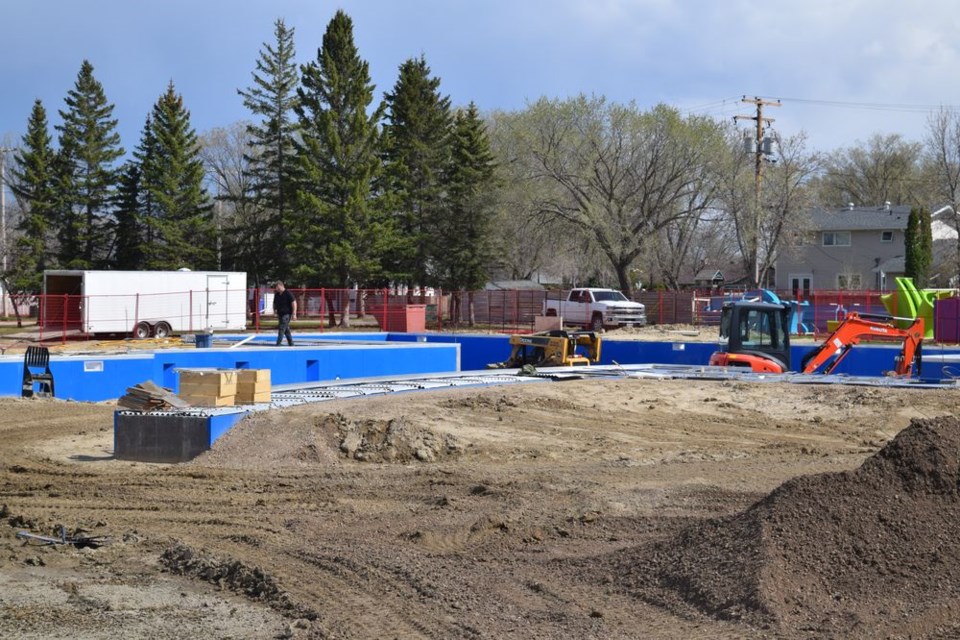In a major development for the new Canora Aquatic Park project, the Town of Canora has been successful in obtaining $743,617 in financial assistance through the Canada Community Revitalization Fund (CCRF).
Canora Leisure Services applied for funding assistance in 2021 through the PrairiesCan recreational stream. The Canora Aquatic Park met the criteria as an eligible project.
“We applied in July of last year, so this recent news is a pleasant surprise,” said Aaron Herriges, Leisure Services Director.
The announcement comes as a welcome development for Canora and the surrounding area.
“We are very excited and appreciative of the federal funding assistance,” said Canora Mayor Mike Kwas. “The Aquatic Park will be a wonderful asset to our community for a long time as we continue to grow and enhance the quality of life for our citizens and visitors.”
The development for the new project is taking place on Fourth Street in Canora across from the Chase Kraynick “Pay it Forward” Splash Park, another popular local facility that opened in 2015.
“Our summer programs are getting a boost with the development of this park,” explained Herriges.
The Canora Aquatic Park Project includes the construction of a 5,297 sq. ft. fully accessible leisure and lap pool, as well as a fully accessible pool service building with supplementary infrastructure. Many of the details of the project can be found on canora.com.
Through the CCRF, the Town was granted the full amount available under the stream which came to $743,617. Confirmation for the grant was received on April 28.
“Investing in outdoor recreational spaces like the Canora Aquatic Park enhances the community and supports the mental and physical well-being of residents and visitors,” stated Daniel Vandal, Minister for PrairiesCan. “Our government is working together with partners to support new infrastructure through the Canada Community Revitalization Fund so people have a place to gather and connect in their community today, and for years to come.”
The benefits to Canora and the surrounding area are expected to be many, ranging far into the future:
• Improved community profile;
• Increase visitor traffic;
• Increase commerce;
• Improve quality of life for all ages by creating a fully accessible community space that is inclusive, safe, and relaxing;
• Increase community growth rate by attracting new families;
• Ensure this important service for the next 50 years and beyond; and
• Create a new space for new program possibilities for seniors and our youth.
“The financial assistance is an absolute homerun for our community. Recreational spaces and facilities are such an important component to maintaining healthy living in smaller communities. So if you can obtain outside funding to relieve the financial weight of these important services, you are setting up your community’s success for the long term,” shared Herriges.
In Saskatchewan communities such as Canora, funding any sizable project weighs heavily on the decision makers.
“Members of town council look at the information in front of them provided by engineers, and staff, so they can make the best decision possible. Knowing how important the recreational service is to keeping the community a viable place to locate to and live relieved some of the pressure I assume. I don’t think anyone could imagine Canora without a swimming pool.”
For every major funding opportunity, the community must take the first step in order to qualify.
“An important bit of information that the public can take away from this news is that this level of grant funding is only available for projects that are ‘shovel ready’ and fully funded,” continued Herriges. “What this means is in order to be eligible, Canora needed to be fully committed to funding this project on its own. A common misconception surrounding this topic is that sizable grant funding can be obtained before any commitment or planning is made. That’s just not the case. You need to commit to building something and the potential funding comes after. So in a sense, if you never start planning to build anything, you will never have a realistic chance to be successful for grants of this size.”
The Town will continue to seek financial aid for this project, wherever it may be available. The organizational, personal, and business donations have been substantial to this point, as the community has fundraised $121,320.17.
“You can still donate to the park and receive the incentives we are offering. A $500 donation gets you a family leisure pass ($250 value), or a 12-swim family pass and your name on permanent signage at the park. All donations come with a charitable tax receipt.”
No matter how much planning goes into this type of project, the weather always has a say. The actual pool construction is about two weeks behind schedule, since the amount of snow and rain this year has set the project back from original the timeline of July 15.
“We are looking at August now, and that doesn’t include landscaping, fencing, parking, and so on. That has to come later,” reported Herriges. “So at this point I don’t think a 2022 opening is very realistic. I can assure the public it will be worth the wait when the park finally opens in 2023.”
Progress on the Aquatic Park project continues.
“The service building is near completion. There are smaller finishing jobs left inside. The exterior still needs stucco among a few other things,” explained Herriges. “They are working on finishing the mechanical corridors around the pool. There is a considerable amount of work left that will go smoothly as long as the weather helps a bit.”




